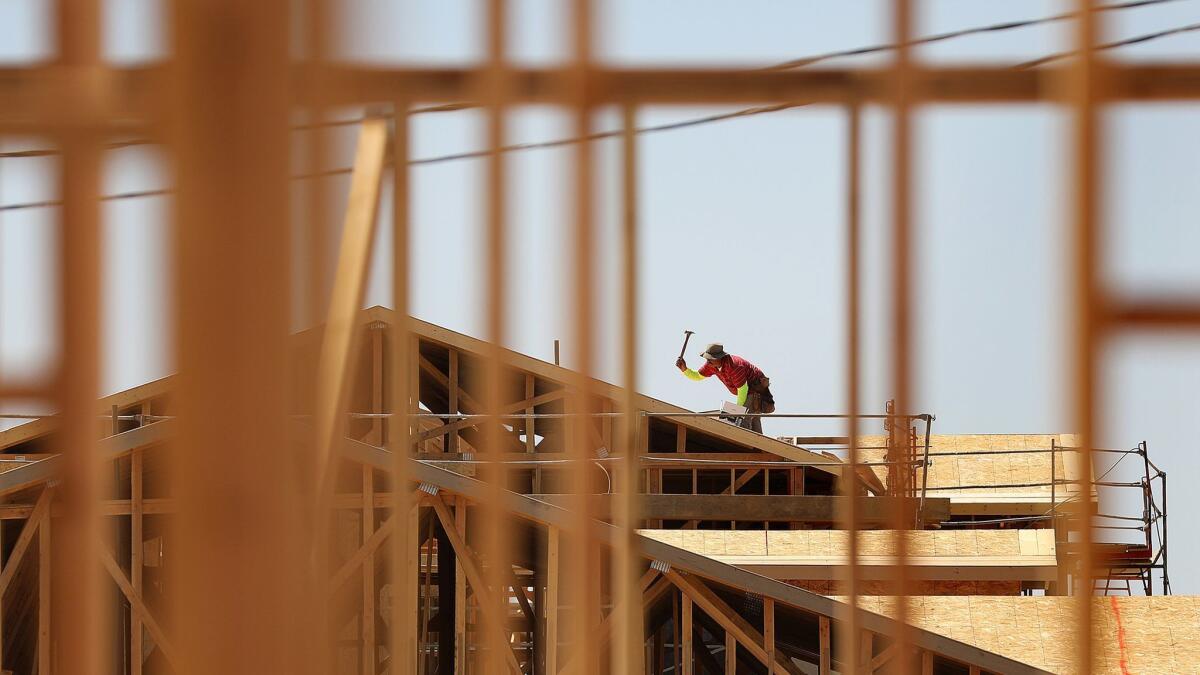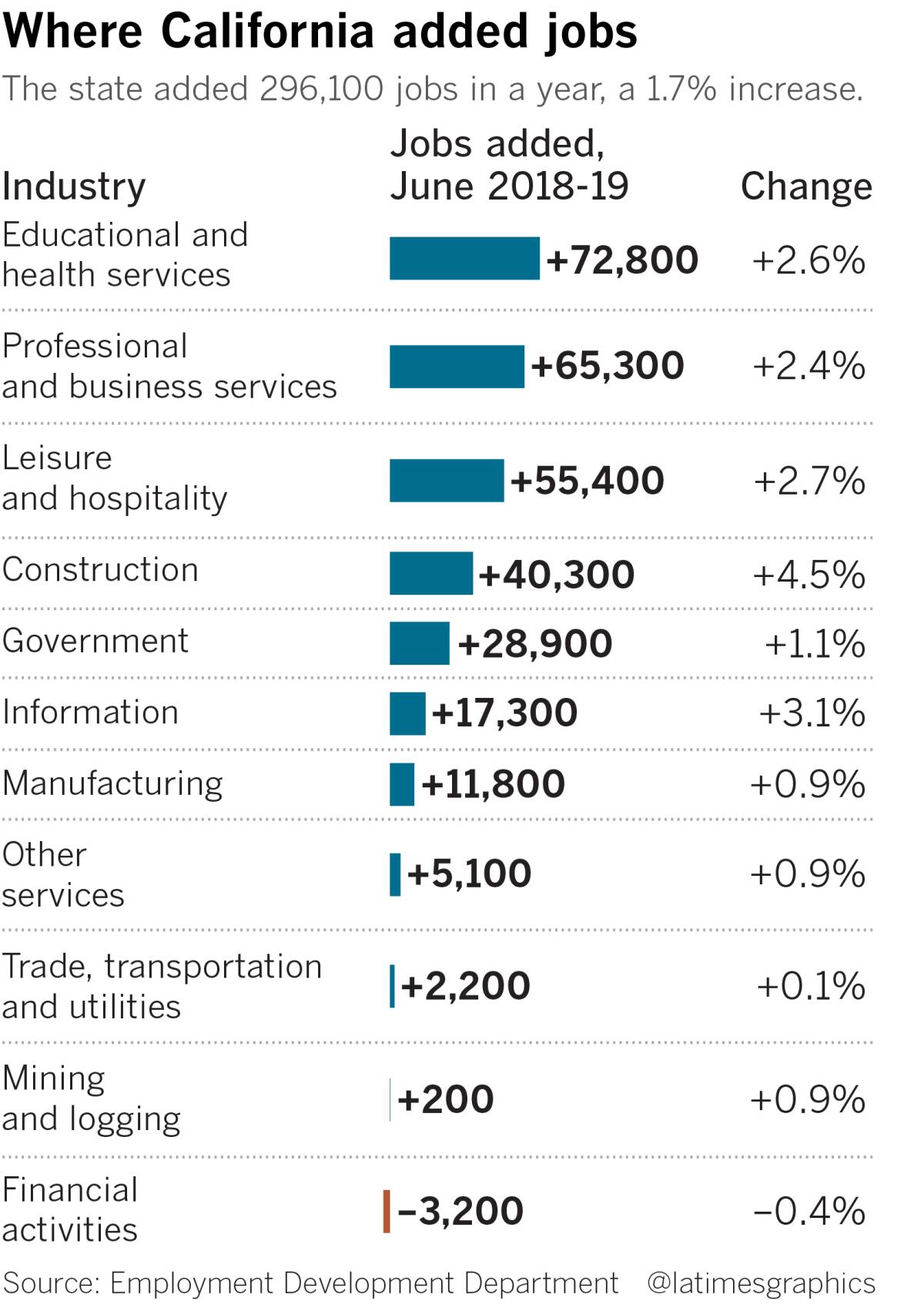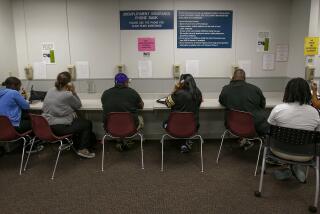California payrolls surged in June, but the labor force shrank

California hiring surged in June, powered by especially strong growth in residential and commercial building as mortgage rates continue to drop.
The state added 46,200 jobs, including 11,900 in construction, as employers in nine of the state’s 11 major sectors grew their payrolls, the Employment Development Department reported Friday.
California’s job growth was double that in May, which saw a revised gain of 21,600 positions. Year-over-year, the state expanded payrolls at a 1.7% rate, outpacing the nation’s 1.5% increase.
“California has faced formidable challenges this year,” said Lynn Reaser, an economist at Point Loma Nazarene University in San Diego. She cited President Trump’s trade war, a downturn in foreign investment, softness in the global economy and the state’s slowing population growth influenced by high housing costs and a decline in immigration.
But, Reaser added, “Strong stock market gains and lower interest rates, along with the diversity of its economy, have enabled California to continue to grow.”
Unlike the nation, where job growth lagged during the first six months of 2019 versus the first half of 2018, California showed an acceleration, Reaser noted. Golden State payrolls gained an average of 29,000 positions a month in the first half of this year versus 26,000 a year ago.
The state’s unemployment rate remained at 4.2% in June, the same as in May and as a year earlier. The U.S. unemployment rate was 3.7%
One worrisome indicator in the June data was a steep drop in the number of people working or looking for work as California, like the nation, faces a tight labor market.
“The labor force shrank by a whopping 57,707 in June and by 161,400 since its recent peak in February,” said Sung Sohn, an economist at Loyola Marymount University in Los Angeles. “Can the job expansion continue without more labor? The state is short of both skilled and nonskilled labor. California is running out of students, mothers and even those on disability to rejoin the labor force.”
Overall, the state’s labor force has expanded by a sluggish 0.3% year-over-year, despite stepped-up efforts by state workforce agencies to encourage the hiring of welfare recipients, ex-offenders, workers with developmental differences and the long-term unemployed.

Higher pay has yet to significantly boost the numbers of job seekers. But in California, Reaser said, “as companies compete for workers, wages are rising. In June, average hourly earnings in the private sector jumped 6.4% from a year ago, more than twice the national average of 3.1%.”
The California data are based on two reports, a U.S. census survey of 5,100 California households, which focuses on workers, and a monthly survey of payrolls of about 80,000 businesses.
After construction, the highest June job gains were in education and health services (+8,200), professional and business services (+8,000) and leisure and hospitality (+4,700). Just two sectors lost positions: Mining and logging (-200) and financial activities (-200).
Los Angeles County added 11,800 jobs in June, led by construction employment, which grew by 3,500. Year-over-year, payrolls grew to 4,571,100 positions, a 1.4% increase.
Los Angeles County’s jobless rate was 4.5%, below the June 2018 rate of 4.6%.
Orange County added 4,200 jobs in June, led by 3,900 positions in construction. Year-over-year, payrolls grew to 1,673,100, an increase of 1.5%.
Orange County’s jobless rate was 3% in June, down from 3.2% in June 2018.
The Inland Empire, which includes Riverside and San Bernardino counties, added 5,100 jobs in June, led by 2,200 positions in transportation, warehousing and utilities. Year-over-year payrolls grew to 1,533,700, an increase of 2.2%.
Unemployment in the two-county region dropped to 4.3% in June, from 4.5% a year earlier.
More to Read
Inside the business of entertainment
The Wide Shot brings you news, analysis and insights on everything from streaming wars to production — and what it all means for the future.
You may occasionally receive promotional content from the Los Angeles Times.











